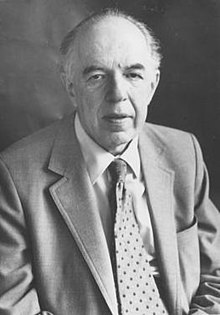
Back إرنست غومبريتش Arabic ارنست جومبريتش ARZ ارنست قامبریچ AZB Ернст Гомбрих Bulgarian Ernst Gombrich Catalan Ernst Gombrich Czech Ernst Gombrich Welsh Ernst Gombrich Danish Ernst Gombrich German Ερνστ Γκόμπριχ Greek
Sir Ernst Gombrich | |
|---|---|
 | |
| Born | 30 March 1909 Vienna, Austria-Hungary |
| Died | 3 November 2001 (aged 92) London, England |
| Alma mater | University of Vienna (PhD, 1933) |
| Occupation | Art historian |
| Notable work | The Story of Art |
Sir Ernst Hans Josef Gombrich OM CBE FBA (/ˈɡɒmbrɪk/; German: [ˈgɔmbʁɪç]; 30 March 1909 – 3 November 2001) was an Austrian-born art historian who, after settling in England in 1936,[1] became a naturalised British citizen in 1947[2] and spent most of his working life in the United Kingdom.
Gombrich was the author of many works of cultural history and art history, most notably The Story of Art, a book widely regarded as one of the most accessible introductions to the visual arts,[3] and Art and Illusion,[4] a major work in the psychology of perception that influenced thinkers as diverse as Carlo Ginzburg,[5] Nelson Goodman,[6] Umberto Eco,[7] and Thomas Kuhn.[8]
- ^ Lyons, M. (2013). Books: a living history. London: Thames & Hudson.
- ^ Liukkonen, Petri. "Ernst Gombrich". Books and Writers (kirjasto.sci.fi). Finland: Kuusankoski Public Library. Archived from the original on 27 August 2014.
- ^ William Skidelsky (17 May 2009). "Classics corner: The Story of Art by EH Gombrich". The Observer. London. Retrieved 3 February 2012.
- ^ Shone, Richard and Stonard, John-Paul, eds.. The Books That Shaped Art History: From Gombrich and Greenberg to Alpers and Krauss, chapter 9. London: Thames & Hudson, 2013.
- ^ Ginzburg, Carlo. "From Aby Warburg to E. H. Gombrich". In Clues, Myths, and the Historical Method, 46. Baltimore: JHU Press, 1989.
- ^ N. Goodman: Languages of Art, Indianapolis and Cambridge, 1976.
- ^ U. Eco: Theory of Semiotics, Bloomington, 1976, pp. 204–205.
- ^ T. S. Kuhn 1962/2012. Structure of Scientific Revolutions, 4th Edition. Chicago: University of Chicago Press, page 160, Ftnt. 1